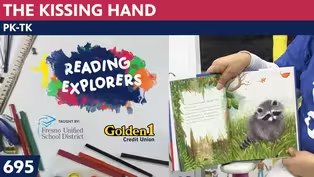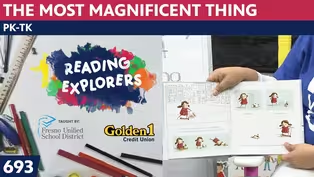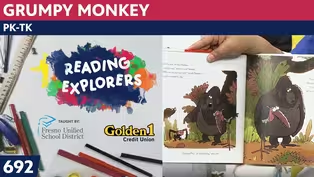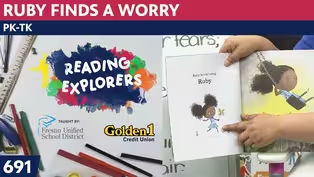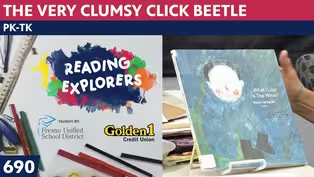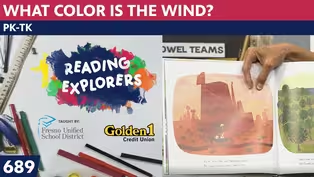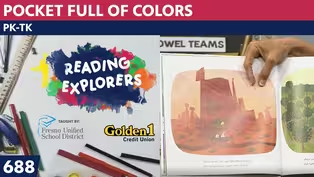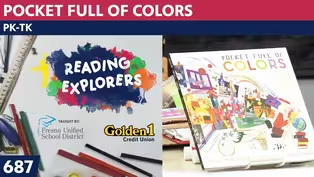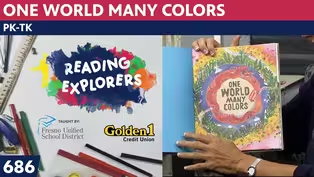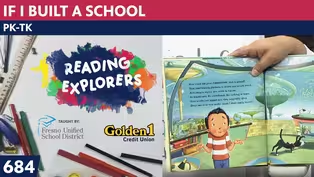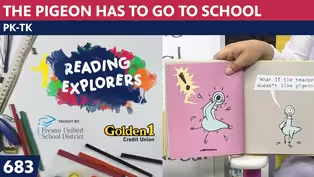
TK-349: Claude Monet
Season 3 Episode 270 | 14m 12sVideo has Closed Captions
Join Mrs. Readwright at Camp Discovery!
Transitional Kindergarten teacher, Mrs. Readwright, welcomes students back to Camp Discovery, a fun learning space packed with reading adventures & fun games!
Problems playing video? | Closed Captioning Feedback
Problems playing video? | Closed Captioning Feedback
Reading Explorers is a local public television program presented by Valley PBS

TK-349: Claude Monet
Season 3 Episode 270 | 14m 12sVideo has Closed Captions
Transitional Kindergarten teacher, Mrs. Readwright, welcomes students back to Camp Discovery, a fun learning space packed with reading adventures & fun games!
Problems playing video? | Closed Captioning Feedback
How to Watch Reading Explorers
Reading Explorers is available to stream on pbs.org and the free PBS App, available on iPhone, Apple TV, Android TV, Android smartphones, Amazon Fire TV, Amazon Fire Tablet, Roku, Samsung Smart TV, and Vizio.
Providing Support for PBS.org
Learn Moreabout PBS online sponsorshipMore from This Collection
Valley PBS and Fresno Unified School District have partnered with Golden 1 Credit Union to create Reading Explorers Lessons for grades Pre-Kindergarten through Third grade. The daily lessons will be taught by Fresno Unified School District teachers and are created to help students practice their reading skills and reinforce lessons during distance learning.
Video has Closed Captions
Valley PBS presents Reading Explorers Lessons for Pre-Kindergarten and TK. (26m 27s)
PK-TK-693-The Most Magnificent Thing
Video has Closed Captions
Valley PBS presents Reading Explorers Lessons for Pre-Kindergarten and TK. (26m 26s)
Video has Closed Captions
Valley PBS presents Reading Explorers Lessons for Pre-Kindergarten and TK. (26m 28s)
Video has Closed Captions
Valley PBS presents Reading Explorers Lessons for Pre-Kindergarten and TK. (26m 28s)
PK-TK-690: The Very Clumsy Click Beetle
Video has Closed Captions
Valley PBS presents Reading Explorers Lessons for Pre-Kindergarten and TK. (26m 22s)
PK-TK-689: What Color is the Wind?
Video has Closed Captions
Valley PBS presents Reading Explorers Lessons for Pre-Kindergarten and TK. (26m 21s)
PK-TK-688: Pocket Full of Colors
Video has Closed Captions
Valley PBS presents Reading Explorers Lessons for Pre-Kindergarten and TK. (25m 58s)
PK-TK-687: Dancing Through Fields of Colors
Video has Closed Captions
Valley PBS presents Reading Explorers Lessons for Pre-Kindergarten and TK. (26m 20s)
PK-TK-686: One World Many Colors
Video has Closed Captions
Valley PBS presents Reading Explorers Lessons for Pre-Kindergarten and TK. (27m 13s)
PK-TK-685: School is Wherever I am
Video has Closed Captions
Valley PBS presents Reading Explorers Lessons for Pre-Kindergarten and TK. (26m 32s)
PK-TK-684: If I Built a School
Video has Closed Captions
Valley PBS presents Reading Explorers Lessons for Pre-Kindergarten and TK. (26m 21s)
PK-TK-683: The Pigeon Has to Go to School
Video has Closed Captions
Valley PBS presents Reading Explorers Lessons for Pre-Kindergarten and TK. (26m 22s)
Providing Support for PBS.org
Learn Moreabout PBS online sponsorship♪ Good morning to a brand new day ♪ ♪ Time to learn and the games to play ♪ ♪ Learning things is so much fun ♪ ♪ Learning is good for everyone.
♪ (bouncy instrumental music) - Hello, early learners.
It's me, Mrs. Reed Wright, I wanna welcome you back to the Art Room.
We are having such a good time learning about art through the ABCs.
And today is the letter S, and I want to sing a hello song and say which animal?
Oh, it's a dog.
And you know what a dog says and we'll say his sound one, two, three times.
Ready?
♪ When dogs get up in the morning ♪ ♪ They always say, good day ♪ ♪ When dogs get up in the morning ♪ ♪ They always say, good day, woof, woof, woof ♪ ♪ This is what they say, roof, roof, roof ♪ ♪ This is what they say ♪ I wonder what your dog sounds like if you have one.
Some of them have that little high peachy bark, woof!
Let's take a look about the ABCs of art.
♪ A, B, C, D, E of art ♪ ♪ That's the way that we will start ♪ ♪ P is for puppet ♪ ♪ Q is for queen ♪ ♪ R is for roses that we have seen ♪ ♪ S is for sunflower ♪ ♪ Trees start with T ♪ ♪ Art and the alphabet, A, B, C ♪ And today is the sunflower S. And this is a bouquet of sunflowers, painted by Claude Monet.
Now, Claude Monet didn't usually do a still life.
Remember he did all of those water lilies in the pond, and the Japanese bridge that we did way back on letter B.
And he did these sunflowers because at the time there wasn't a lot of money, and people couldn't travel very much.
So what he did was go down to his own garden, and found things to paint.
So he cut this bouquet of sunflowers, and we know that Vincent van Gogh painted sunflowers, but Vincent van Gogh, you could see all of his brush strokes, and they were very, very defined.
But Claude Monet took time to look at each of the sunflowers, and made each one look just like what he was looking at.
Let's look at the riddle and rhyme that I wrote for that.
Claude Monet painted sunflowers gold.
He painted them big, and bright, and bold.
So what we're going to do today is paint sunflowers.
Now, I know that it's going to be a little hard to paint them at times, because the middle of it is going to be kind of a brownish color.
The outside is going to be yellows, and a lot of the warm tones.
And so when I paint by petals, I'm gonna try and stay away from the brown paint.
And then at the end, we're going to take pieces of tissue paper, and put it on top of where the paint is still wet.
So it'll have kind of a 3D effect, where the petals will look like they're standing up in the picture.
I think it's going to be great.
I think you'll like it.
All right.
So let me set things aside, and pick up my table to get ready.
I'm using temper paint, but you could use watercolors.
And if you don't have that paints, you know you can use your crayons, and you can get the same idea going with it.
Now, I'm trying to do this so that I can put my, make it even on here.
Okay, here we go.
So I'm getting all of my brushes, and I'm going to start out with a medium size brush.
Because I think I'm going to make two sunflowers.
I've decided already that I want to mix up some colors.
And I have some paper towel here already, but I'm going to use my pie pan for my palette.
And I use that to get my paints to mix.
So if I put my brown in here, and you know, if you're going to do a shade, you have to start out with the color first.
The hue first, and then the tiny bit of black to make the shade.
So I'm gonna put the black over here, because I want it to be where it's mixed in.
And I don't want to totally mix, mix, mix my colors.
I'm going to go on here, and do some brown and black like this.
So it looks kind of rough, and not completely one color or another.
So I'm using the brown for that first sunflower, and I'll move down a little bit.
You can put your sunflower wherever you want.
Do you want just two like I'm going to do?
I'm doing that for a couple of reasons.
One, I think I can make it look balanced and beautiful.
And two, I don't always have time to really get started and show you what I want to do.
So I will do it like this.
Now this brush needs to be put away, and I'm going to get out another one for the flower petals.
And they aren't just solid yellow.
So I'm going back in and bringing paint from my container, so that I do not have them get all muddy in there.
And muddy just means, not with dirt and water like that kind of mud, but when they look the color of mud.
I also want to add a little bit of orange off to the side because I want to do some yellow-orange, and orange.
And on the other side, I'm going to put a glob of orange, and put a little bit of red in there, so that it has a little darker red that'll be a red-orange.
Cause I'm putting more orange than red.
So there we go.
That looks kind of good, but I think a little more red might be even better.
All right.
Now, I'm going to put that away for now, because it is to painty, and I'm going to get out a different one to start with yellow.
I might put a tiny bit of the green in there, to make it a yellow-green.
Now this paint is dried up in my egg carton.
So I'm just going to mix that green over to the side.
Oh, that I like.
Okay, I'm ready to start.
So I'm just gonna put this here, and just make these come out.
Still has a little too much green on it from going into the green.
So I'm gonna wash it off a little.
So here we go.
Getting that yellow and going around.
Do you notice I'm really trying to stay away from my brown?
Cause the brown will make the yellow be a brownie-yellow.
Kind of like mustard.
And I don't want that.
And notice I'm letting my paint be globbed on there a little bit.
And nothing is, not one petal is exactly the same color as another, because I kept mixing in other colors with it, down here.
I'm doing the same thing.
I'm putting my colors and loading 'em up.
Putting it on here.
Still doing it.
Have you noticed I'm really trying to start from the brown and go out?
I just almost accidentally let my brush get into the brown.
Oh, a little bit did right there, but that's okay.
Cause I can just get in close and then pull, in close and then pull.
Now I'm going to go around with some of this orangy-red to the ends, and get in there like that.
And I'll mix it in a little bit.
Cause the ends of these flowers that he painted were kind of orangy.
And I think I like that, how he made it look very mixed in.
If I feel like I put too much, I can go back with my brush, and brush it out.
Still going in here.
I think it looks pretty good.
You know what else I need to add to it, don't you?
The green.
Cause it needs the leaves to make it look really nice and colorful.
And I'm going my paint brush in the green, and just make my leaves out here.
They might be a little bit too bright green, so I can go in with a blue.
I'm just getting in all the places where my paint dried in the bucket, and connect it this way.
And I have still my water colors here if I like the looks of that.
Cause this really looks like it needs some other color in there.
It's too greeny for me.
Oh yeah, there we go.
I added a little brown to it, and now looks more like a leaf color.
And you know the leaves too, just like the sunflowers, they are not all one color.
So I'm going to bring it around.
And do you notice I made like a little wave of the notion up like that?
So that the leaves have a little bit of a different shape, and I will get some more green, and I'll draw another one and mixed by colors, just on the paper itself.
I don't always have to do a mixture in my palette, and I might like a little blue on that one.
So I'm going to go in there.
And I really did like when the brown was mixed in with it, cause it made it a little more like leaves in my own garden.
Maybe I'm not watering enough.
Is that why they're kind of brown?
But I will go around with each of these, like this.
Now the thing I really wanted you to see, that I'm going to add to this, is when I use my, whoa tissue paper, careful paints don't fall apart now.
Okay.
The paint is still wet, but I'm worried that it may not hold my tissue paper.
So I'm going to put some dots around.
Kind of around where the brown is, and let it go on top.
And I brought a bunch of different colors of yellow and orange.
I bought this tissue paper at that store where you can buy everything for a dollar.
And that way I can use a bunch of different colors and not worry about how much I'm using.
Now, I like the look of the petals being kind of torn on the end, so I'm gonna make this go down a little bit, but I will tear it at the end.
So that it kind of looks how the sunflower petal really is.
And if it's too big and long, I will just cut it off a little bit.
Oh, get off of here you.
Yup, it got a little paint on it, and it made it not stick up very much.
So I think I need to make these smaller.
I'll just cut off a little piece like this and make them smaller.
And you know what happens if it's too big?
You just cut it a little smaller.
Pick 'em up, and I'm gonna pinch the end where I'm putting it gluing it here, and making it stick up.
Pinch the end and stick it on there.
So not only does it look like the piece of petal on the top, the petals are beneath it too, so it makes it look more deep.
When they say, "Oh your picture is beautiful."
I say, "Yes, did you notice the depth of color and texture?"
And people think, Oh my goodness, she's using texture words on this?
Cause it is.
It's not just flat anymore.
It has these petals that stick up, and you know, you take your time because you don't need to rush.
I just wanna make sure every time we're working on a project, that you see that second step or the third step.
So you're not left thinking, hey, how was she gonna add that paper to it?
But do you like how it stands up?
I do.
I might even bring some green, and make the leaves stand up too.
Notice I'm just using all of my scraps, and getting it all like this.
Boys and girls, you know what comes after the letter S?
It's T. And who we're going to be studying tomorrow is our old friend who used gold.
Do you remember what his name is?
Gustav Klimt.
And we're going to be doing something that he did in the forest.
And we're gonna be talking about trees.
So let's get ready to say goodbye to one another, while I do a little bit more of gluing on these petals.
And we're gonna sing, "Oh, it's time to say goodbye to all my friends."
Think I have a little bit more.
Maybe even some of this orange.
I wonder if that would look good on it.
♪ Oh, it's time to say goodbye to all my friends ♪ ♪ Oh, it's time to say goodbye to all my friends ♪ I don't like the orange.
♪ Oh, it's time to say goodbye ♪ ♪ Give a smile and wink your eye ♪ ♪ Oh, it's time to say goodbye to all my friends ♪ Now, tomorrow, if you want to make the project with me, I'm going to be using yarn, and some cardboard, and some paint.
So if you have those materials, bring them with you, and I'll see you tomorrow.
Thanks for joining me today, boys and girls.
See you tomorrow.
(upbeat instrumental music) ♪ Good morning to a brand new day ♪ ♪ Time to learn and games to play ♪ ♪ Learning things is so much fun ♪ ♪ Learning is good for everyone ♪ (upbeat guitar music)
Support for PBS provided by:
Reading Explorers is a local public television program presented by Valley PBS
